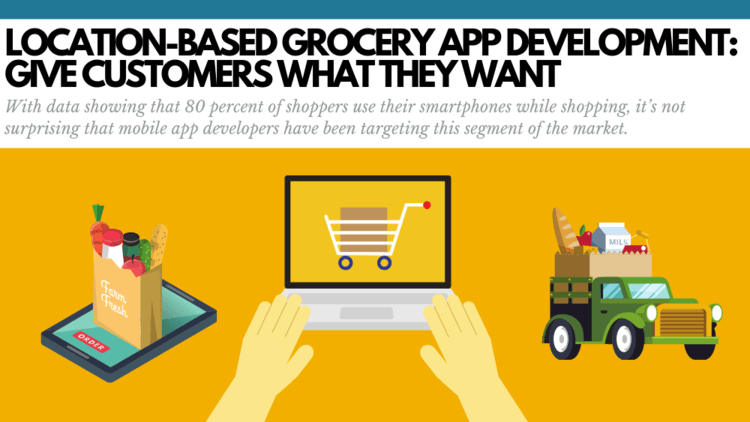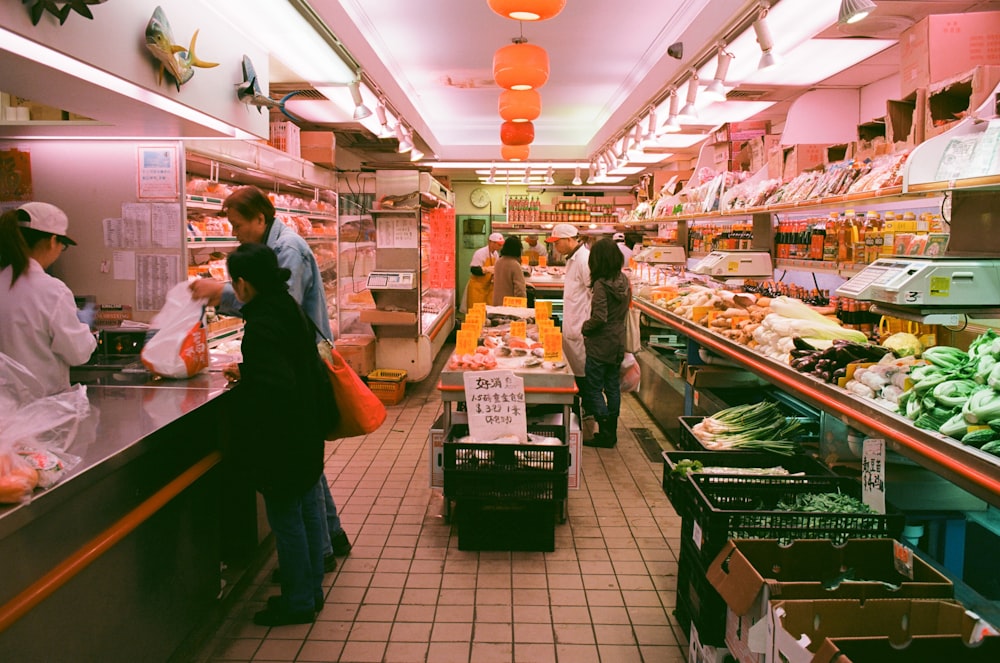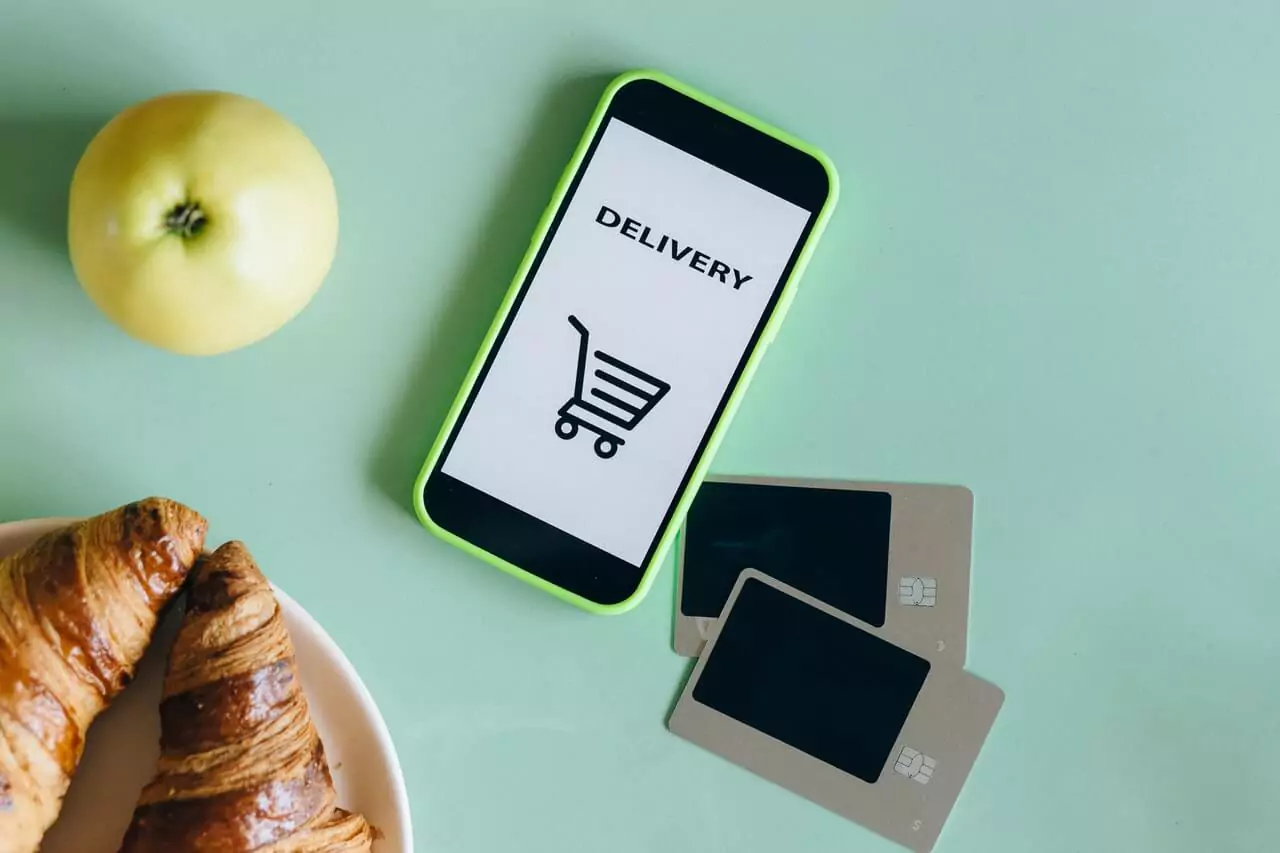Originally published July 15, 2019 , updated on May 31, 2023
A lot of modern technological advances are driven by people’s ever-growing need to save time and money and organize their everyday routines efficiently. Taking care of day-to-day housework can be unpleasant and stressful for a lot of people; in particular, making a food shopping list and purchasing household supplies is a significant part of what needs to get done to keep a household functioning.

With data showing that 80 percent of shoppers use their smartphones while shopping, it’s not surprising that mobile app developers have been targeting this segment of the market.
Let’s say you’re going to develop an app for groceries. Where do you start? To find the most successful approach, you need to understand how people use mobile technology while shopping.
Nancy M. Childs PhD, a professor of food marketing, outlines three primary motivations of grocery shopping app users in her book “The Digital Grocery Commerce: Insights for Enhancing Consumer Connection with Grocery Shopping Apps”:

1) Consumer personalization. An app should respond to a user’s personal requirements and cater to their needs.
2) Convenience. An app should be easy to use and intuitive so that a user doesn’t end up wasting their time.
3) Economic advantages. An app should offer ways for a user to save money, such as coupons or loyalty programs.
What types of apps help businesses bring home the bacon
A shopping list may be a standalone application or an additional feature of grocery delivery, loyalty, or recipe book apps. It’s crucial for a business to decide on a specialization to effectively implement the necessary app features before grocery app development. Let’s view each type of grocery app in more detail.
Grocery Delivery Apps
There’s growing demand for online grocery delivery. The grocery industry is huge by all measures and is constantly developing. Grocery delivery systems and grocery apps startups have been regularly popping up, and some of them have managed to become tremendously successful.
Grocery providers Instacart, which works in 40 US states, and Shipt, which operates in more than 257 cities, are two of the industry leaders. Amazon recently announced free two-hour delivery of Whole Foods products for Prime customers in several US cities and its intention to expand this business shortly. Walmart Grocery Delivery is now available at over 800 stores, and Walmart plans to add another 800 in 2019.
The Instacart platform is a good example of a marketplace that makes it easy for users to create grocery shopping lists, place an order from Whole Foods, Costco, and Safeway, and get delivery within an hour. It’s fast, cheap, and allows users to combine items from all three stores in one order.
Instacart business model is a combination of e-commerce, on-demand, sharing, subscription, and aggregator models. The whole process of ordering groceries via Instacart can be briefly described as follows:
-
A customer creates a list of groceries and pays Instacart.
-
A personal shopper gets this order and collects the groceries.
-
The shopper pays the bill via an Instacart prepaid debit card.
-
The shopper delivers these products to the customer.
You can read more about creating a grocery delivery service like Instacart in our blog post on how much it costs to create an on-demand delivery app.
Grocery Loyalty Apps
Loyalty programs are firmly established as one of the most effective methods in grocery app development to increase revenue and ensure customer loyalty. According to The Loyalty Report 2018, more than 35,500 of 50,000 surveyed American and European consumers who are members of loyalty programs stated that membership is fundamental to their relationship with brands.
Nowadays, most retailers build a mobile app for their loyalty program. For instance, Starbucks launched My Starbucks Rewards by means of the Starbucks app. Customers have to order or pay via the Starbucks app to earn loyalty points (stars). Centralizing customer transactions is a priceless source of information on customer preferences and behavior, empowering a business to offer more relevant campaigns and communication with consumers.
Moe’s Southwest Grill, a chain of restaurants, offers an extensive rewards program with many levels of earning potential through the Moe Rewards app. Getting to the next level grants a user greater earning potential. Additionally, the app allows users to earn rewards by referring friends to the program. Even though this app is criticized for being difficult to use and constantly crashing, the loyalty program idea behind the poor implementation is excellent.
A shopping list feature can be part of a grocery loyalty app, enabling users to shop conveniently along with enjoying benefits of the loyalty program.
Apps with Built-in Recipe Books
AnyList and Yummly are only two examples of a very popular type of grocery list app that combines a recipe book with standard grocery app functionality. When AnyList users add recipes, each ingredient is automatically added to their grocery list. BigOven provides over 350,000 recipes, featured collections, and menus curated by season, holiday, course, lifestyle, diet, and more.
Recipe manager Paprika has a built-in browser that helps users find recipes they like on the web and import them to their personal recipe list. Paprika stores recipes and users can add all ingredients for a recipe to a grocery list, then remove the ones they already have.
What to stuff your grocery list app with
Taking a deeper look into how t
o make grocery shopping apps successful, we came up with a list of features that are the most desirable ones. The second list we provide contains features that you need to implement carefully as they may not be popular with all users (based on Google Play and App Store reviews).
Seven Most Desired Features in Grocery App Development

1. Shopping List
This is the core feature of a grocery shopping list and grocery app development. In order to make this feature more convenient, it’s a good idea to add an in-app dictionary. All items that a user enters into the app can be added to the dictionary so the app can autocomplete them next time. Grocery list apps featuring built-in dictionaries allow users to quickly add items to their lists. Users can also use saved shopping lists and view frequently bought items.
This significantly simplifies shopping for those who tend to purchase the same products. The best apps also include barcode scanners, email sharing, and online list updating. Lists can be shared with a user’s family members, and if somebody edits the list, others are notified. Mealime has a sophisticated built-in grocery list feature. It allows users to make and optimize easy-to-understand grocery lists based on meal plans. When a user makes a new meal plan, the system automatically creates a grocery list of all the necessary products for the week.
2. Ability to Track Spending in Grocery App Development
Users want to have an overview of their spending in their favorite supermarket combined with infographics that indicate the main areas of spending and recommend a strategy for cutting down expenditures. Interestingly, even though the ability to track spending is listed among one of the most desirable features, top grocery shopping apps in the App Store and Google Play Store tend to almost completely ignore this feature. This tendency doesn’t apply to Grocery IQ, however. This app allows users to stay within their budgets by informing about the expected cost of items on a list. But to enjoy this benefit, a user has to manually enter prices into the app.
3. Grocery Shopping List Reminders
A grocery shopping app can remind users to buy a standard list of groceries that they’re most likely to run out of by the end of the week (such as milk, bread, and eggs). For example, an app called Daily Bread integrates with a reminders app and lets users know when they’re about to run out of groceries.
4. Coupons and Loyalty Programs in Grocery App Development
Grocery coupons come in different forms in grocery app development, both digital and paper. They represent different discount programs and seasonal, weekly, and daily sales. Grocery apps that generate or find relevant coupons based on shopping history, current shopping lists, or a user’s location can help with family budgeting. Some apps like Grocery IQ work with coupons.com. When users add something, the app alerts them if there are coupons available to print or load to their grocery store loyalty card. Flipp allows shoppers to browse, filter, and find bargains based on grocery essentials by matching local deals with coupons from a user’s favorite brands.
Most users are equally enthusiastic about digital and printed coupons provided that an app gives them a simple way to turn virtual coupons into real dollar savings. Users will certainly appreciate customized coupons based on a current shopping list. The Grocery IQ and SavingStar apps have been praised for helping users optimize their use of coupons and keep up with ever-changing sales and discounts. Favado, a coupon app, allows users to find the best prices in more than 65,000 leading grocery and retail stores such as CVS and Walmart.
5. Barcode Scanning and Aisle Locations
Barcode scanners help users find out as much as possible about products quickly. To scan their groceries, users aim their phone camera at the barcode of an item and see the price on their screen. They can then add the item to an electronic shopping basket. A barcode scanner can also provide information about nutritional value and dietary recommendations. For example, the ShopWell app with a barcode scanner function helps users eat healthier and achieve their nutrition goals.

It’s useful for managing weight and conditions like diabetes, high blood pressure, and celiac disease. ShopWell can also help users maintain a vegan or vegetarian diet. The barcode scanner in the Out of Milk app lets users quickly create shopping lists. A shopper can just launch Out of Milk and scan a barcode to add an item to their shopping list. Showing aisle locations for groceries is also a good way of grocery app development to provide convenience for users. Adding a store map will enable customers to get more detailed information on a store.
6. Prompt and Easy Sharing
This feature is crucial to make shopping easy for users. A person who creates a grocery list can share it with another person who’s in the store. Users should be able to share lists in one tap.
7. Gamification in Grocery App Development
Even though gamification is widely adopted by educational, health, and fitness apps, it hasn’t been fully mastered by grocery apps yet. However, adding a gamification component might make grocery store apps more attractive for users. This can be going on a treasure hunt for coupons, setting a shopping budget with automatic withdrawing of unspent money from a user’s bank account to a specific savings goal, or something else.
Post Views: 139



















